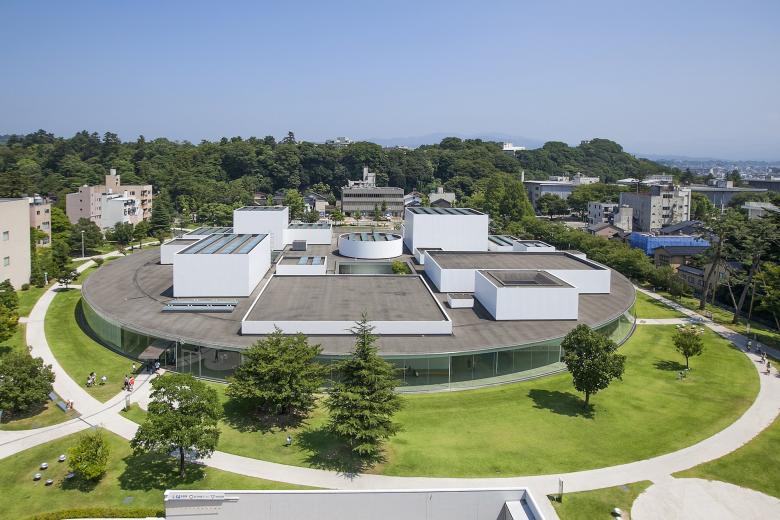Praemium Imperiale to SANAA
John Hill
16. September 2022
21st Century Museum of Contemporary Art, Kanazawa, 2004. (Photo: 金沢市/Wikimedia Commons)
Japanese architects Kazuyo Sejima and Ryue Nishizawa of SANAA have been named recipients of Japan Art Association’s 2022 Praemium Imperiale, one of the world's most prestigious awards for architects and other artists.
Described by the Japan Art Association as a studio "best known for its light, fluid forms that shun hierarchy and sit in harmonious relationship with their surroundings," Kazuyo Sejima + Ryue Nishizawa / SANAA are one of five 2022 laureates across the same number of disciplines:
- Painting: Giulio Paolini (Italy)
- Sculpture: Ai Weiwei (China)
- Architecture: Kazuyo Sejima + Ryue Nishizawa / SANAA (Japan)
- Music: Krystian Zimerman (Poland/Switzerland)
- Theatre/Film: Wim Wenders (Germany)
The laureates of the 33rd Praemium Imperiale were announced in multiple cities on Thursday, September 15. Each laureate receives an honorarium of 15 million yen ($105,000 USD) and a testimonial letter, with medals presented by Prince Hitachi to follow at an awards ceremony in Tokyo on October 19.
Kazuyo Sejima + Ryue Nishizawa / SANAA follow Glenn Murcutt, last year's winner in the Architecture category. Other recent recipients include Tod Williams and Billie Tsien (2019), Christian de Portzamparc (2018), Rafael Moneo (2017), Paulo Mendes da Rocha (2016), Dominique Perrault (2015), and Steven Holl (2014). No awards were given in 2020 due to the coronavirus pandemic.
One has to go back to 2010, and Toyo Ito, to find the previous architect from Japan receiving an award. Before that were Yoshio Taniguchi (2005), Fumihiko Maki (1999), Tadao Ando (1996), and Kenzo Tange (1993). Like many of the international Praemium Imperiale laureates in the Architecture category, Sejima and Nishizawa are also recipients of the Pritzker Architecture Prize, having been named laureates of that prestigious prize in 2010.
As such, SANAA's architecture needs very little in the way of introduction. The firm was established in 1995, with Sejima previously working in the office of Toyo Ito and Nishizawa, who is ten years younger than Sejima, joining her then eponymous office in 1990. The two architects carry on individual practices as well as SANAA, though the joint office is responsible for cultural and institutional projects in Japan and around the world.
SANAA's notable buildings are many, though the prize announcement highlights a half dozen of them: 21st Century Museum of Contemporary Art, Kanazawa (2004); De Kunstlinie Theatre and Cultural Centre, Almare (Netherlands, 2006); New Museum of Contemporary Art (USA, 2007); ROLEX Learning Center (Switzerland, 2009); Louvre-Lens (France, 2012); and Bocconi University New Urban Campus (Milan, 2020).
Watch the September 15 announcement of the laureates in this short film, in Japanese:
In addition to Kazuyo Sejima + Ryue Nishizawa / SANAA, two other 2022 laureates should be of interest to architects and architecture buffs. Sculpture laureate Ai Weiwei is described by the Japan Art Association as an "artist, activist and filmmaker," and "one of the most influential cultural figures working today," but for many years he was also practicing architecture under the studio FAKE Design. He designed numerous buildings in China, including his own home and studio, which was destroyed by Chinese officials in 2018. In his time as an architect, Weiwei collaborated with Herzog & de Meuron on the Bird's Nest stadium in Beijing and the Serpentine Gallery Pavilion in London, collaborated with HHF on projects in the United States, and led the masterplan for the failed ORDOS 100 in Inner Mongolia.
Theatre/Film laureate Wim Wenders is also worth pointing out, though not for direct relationships to architecture that Ai Weiwei has, but because of an attitude to cities and landscapes that comes across in his films and photography. Critic Karrie Jacobs summed it up a few years ago in a piece titled "Everything I Know About Architecture, I Learned From Wim Wenders," writing that "his camera makes everything in the built environment, from major works of architecture to the detritus of urban life, look so glorious." The Japan Art Association's announcement reveals that Wenders is currently working on a feature film in conjunction with The Tokyo Toilet, a project by the Nippon Foundation that is replacing old facilities with fully accessible, eye-catching designs courtesy of renowned architects.
